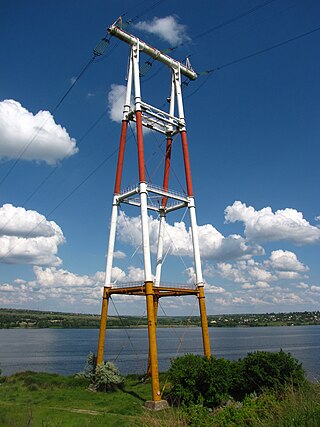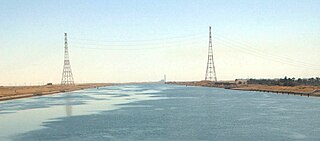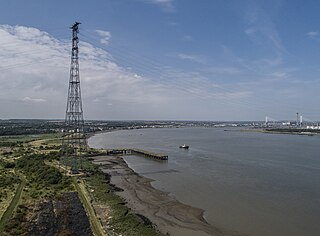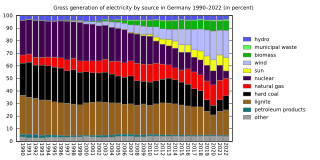
Bosporus overhead line crossings refers to the three transmission line crossings of the Bosporus, the strait in Istanbul, Turkey.

Bosporus overhead line crossings refers to the three transmission line crossings of the Bosporus, the strait in Istanbul, Turkey.
The Bosporus overhead line crossing 1 was the first overhead transmission line crossing the Bosporus. It was inaugurated in 1957 and it is designed and operated for two 154 kV circuits. Although apparently designed for overhead ground wires, none are currently present. The span width is 1,782 m (5,846 ft), clearance over Bosporus is 59 m (194 ft). The pylons carrying this span are 113 metres tall.


Bosporus overhead line crossing 2 is the second transmission line across Bosporus. It is designed for two 420 kV circuits and it went in service in 1983. It has a span width of 1,906 m (6,253 ft) and is mounted on 124 metres tall pylons.
Bosporus overhead line crossing 3 is the third overhead line crossing of the Bosporus. It is adjacent to the second crossing, and is designed for four 420 kV circuits, but can be used after some re-engineering work also for 800 kV lines. Since 1999, two of the four circuits are in use. The pylons on which the 1,884 m (6,181 ft) crossing span is mounted are 160 m (520 ft) high.



A cable-stayed bridge has one or more towers, from which cables support the bridge deck. A distinctive feature are the cables or stays, which run directly from the tower to the deck, normally forming a fan-like pattern or a series of parallel lines. This is in contrast to the modern suspension bridge, where the cables supporting the deck are suspended vertically from the main cable, anchored at both ends of the bridge and running between the towers. The cable-stayed bridge is optimal for spans longer than cantilever bridges and shorter than suspension bridges. This is the range within which cantilever bridges would rapidly grow heavier, and suspension bridge cabling would be more costly.

A transmission tower, also known as an electricity pylon or simply a pylon in British English and as a hydro tower in Canadian English, is a tall structure, usually a steel lattice tower, used to support an overhead power line.
The HVDC Volgograd–Donbass is a 475 kilometres (295 mi) long bipolar ±400 kV high voltage direct current powerline used for transmitting electric power from Volga Hydroelectric Station at Volgograd in Russia to Donbas in eastern Ukraine and vice versa.

The Pylons of Messina are two free-standing steel towers, the Sicilian one in Torre Faro and the Calabrian one in Villa San Giovanni. They were used from 1955 to 1994 to carry a 220 kilovolt power line across the Strait of Messina, between the Scilla substation in Calabria on the Italian mainland at 38°14′42″N15°40′59″E and the Messina-Santo substation in Sicily at 38°15′57″N15°39′04″E.

The Pylons of Cádiz, also known as the Towers of Cádiz, are two 158 m (518 ft)-tall pylons supporting a double-circuit 132 kV three-phase AC powerline over the bay of Cádiz, Spain, running from Puerto Real Substation to the substation of the former Cádiz Thermal Power Station, situated on the peninsula upon which the city of Cádiz stands.

An overhead line crossing is the crossing of an obstacle—such as a traffic route, a river, a valley or a strait—by an overhead power line. The style of crossing depends on the local conditions and regulations at the time the power line is constructed. Overhead line crossings can sometimes require extensive construction and can also have operational issues. In such cases, those in charge of construction should consider whether a crossing of the obstacle would be better accomplished by an underground or submarine cable.

A dead-end tower is a fully self-supporting structure used in construction of overhead power lines. A dead-end transmission tower uses horizontal strain insulators at the end of conductors. Dead-end towers may be used at a substation as a transition to a "slack span" entering the equipment, when the circuit changes to a buried cable, when a transmission line changes direction by more than a few degrees, or at intervals along a straight run to limit the extent of a catastrophic collapse.

An overhead power line is a structure used in electric power transmission and distribution to transmit electrical energy across large distances. It consists of one or more uninsulated electrical cables suspended by towers or poles.

The Suez Canal overhead powerline crossing is a major electrical power line built across the Suez Canal in 1998, located near Suez, Egypt. It is designed for two 500 kV circuits.
Square Butte is the designation of a high-voltage direct current transmission line in the United States between the Milton R. Young Power Plant near Center, North Dakota at 47°4′18″N101°11′45″W and the Arrowhead converter station near Adolph at 46°46′25″N92°17′39″W. It was built by Minnkota Power Cooperative and Minnesota Power and went in service in 1977. In 2009, an agreement was executed between the two companies whereby Minnkota gets the rights to all the power currently transmitted over the line while Minnesota Power takes full ownership of the line to transmit power from new sources in the Center area.

The Kerinchi Pylon is a lattice-steel transmission tower located near Menara Telekom in Kerinchi, Kuala Lumpur, Malaysia.

California Oregon Intertie (COI), identified as Path 66 by Western Electricity Coordinating Council (WECC), is a corridor of three roughly parallel 500 kV alternating current power lines connecting the electric grids of Oregon and California. Their combined power transmission capacity is 4800 MW.
The Yangtze River power line crossings are overhead power lines that cross the Yangtze River in China. There are at least three power line crossings on the Yangtze River at Jiangyin, Nanjing, and Wuhu. The towers of the crossing in Jiangyin are among the highest in the world.

The 400 kV Thames Crossing is an overhead power line crossing of the River Thames, between Botany Marshes in Swanscombe, Kent, and West Thurrock, Essex, England. Its towers are the tallest electricity pylons in the UK.
The Saint Lawrence River HVDC Powerline Crossing is the crossing of Hydro-Québec's Quebec-New England HVDC transmission line over the Saint Lawrence River between Grondines and Lotbinière, Quebec, Canada. The crossing is remarkable, for being first implemented as an overhead crossing, and then later replaced by a cable tunnel. Hydro-Québec wanted to complete the transmission line in time, which was only possible with an overhead crossing of Saint Lawrence River. However, due to the negative visual impact of the large towers of the overhead crossing on the local populations of Grondines and Lotbinière, it was decided to build a cable tunnel under the river, although this made the project more expensive.
HVDC Ekibastuz–Centre is an unfinished HVDC transmission line between Ekibastuz in Kazakhstan and Tambov in Russia whose construction was started in 1978. It was planned to have a length of 2,414 kilometres (1,500 mi), which would have made it the longest powerline of the world with a maximum transmission rate of 6,000 MW and a transmission voltage of 750 kV between conductor and ground. For this line the erection of 4,000 pylons, most 41 metres (135 ft) tall, were required. Several hundred kilometres were built, including a Volga crossing on three 124 metres (407 ft) tall towers near Saratov, which were erected between 1989 and 1991. At Ekibastuz construction work at the terminal was started, while it was not the case at Centre substation, Tambov.
The Vetrino–Isaccea–Yuzhnoukrainsk powerline is the third 750 kilovolts powerline running from Ukraine to the European Union.

Germany's electrical grid is part of the Synchronous grid of Continental Europe. In 2020, due to COVID-19 conditions and strong winds, Germany produced 484 TW⋅h of electricity of which over 50% was from renewable energy sources, 24% from coal, and 12% from natural gas. This is the first year renewables represented more than 50% of the total electricity production and a major change from 2018, when a full 38% was from coal, only 40% was from renewable energy sources, and 8% was from natural gas.
The Zhoushan Island Overhead Powerline Tie is a 220 kV three-phase AC interconnection of the power grid of Zhoushan Island with that of the Chinese mainland. It runs over several islands and consists of several long distance spans, the longest with a length of 2.7 kilometres (1.7 mi) south of Damao Island. This span uses two 370-metre-tall (1,210 ft) pylons, which were the highest electricity pylons in the world, until 500kV line to Zhoushan from mainland was completed. The north tower on Damao Island was completed in 2009, and the south tower on Liangmao Island was completed in 2010. These pylons resemble those of the Messina Strait, but are steel-tube lattice structures.
Powerline river crossings comprise both overhead lines and cable tunnels beneath rivers and estuaries. Overhead power lines are supported on towers which are usually significantly taller than overland pylons and are more widely spaced to cross the river in a single span. Tall pylons ensure that the electricity cables which they support provide an adequate safety clearance for river traffic.